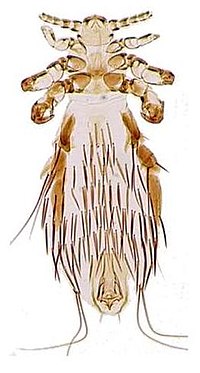
Photo from wikipedia
Nearly all lineages of birds host parasitic feather lice. Based on recent phylogenomic studies, the three major lineages of modern birds diverged from each other before the Cretaceous-Paleogene (K-Pg) mass… Click to show full abstract
Nearly all lineages of birds host parasitic feather lice. Based on recent phylogenomic studies, the three major lineages of modern birds diverged from each other before the Cretaceous-Paleogene (K-Pg) mass extinction event. In contrast, studies of the phylogeny of feather lice on birds, indicate that these parasites diversified largely after this event. However, these studies were unable to reconstruct the ancestral avian host lineage for feather lice. Here we use genome sequences of a broad diversity of lice to reconstruct a phylogeny based on 1,075 genes. By comparing this louse evolutionary tree to the avian host tree, we show that feather lice began diversifying on the common ancestor of waterfowl and landfowl, then radiated onto other avian lineages by extensive host-switching. Dating analyses and cophylogenetic comparisons revealed that two of three lineages of birds that diverged before the K-Pg boundary acquired their feather lice after this event via host-switching.Robert de Moya et al. use comparative genomics of avian lice to reconstruct the phylogeny of these parasites. They show that feather lice diversified on the common ancestor of waterfowl and landfowl, and then radiated onto other avian lineages through host-switching.
Journal Title: Communications Biology
Year Published: 2019
Link to full text (if available)
Share on Social Media: Sign Up to like & get
recommendations!